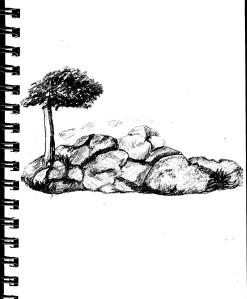Going back to drawing in black and white has been a good learning experience for me. Perhaps the most important lesson it’s taught me is the value of value. We list value — or tone — as one of many elements in art, but of them all, value might well be the most important. It’s the subtle difference in tone that turns our lines into forms and creates depth in our drawings. Value gives our art a three-dimensional quality that makes objects and scenes appear life-like to our eyes.
The importance of value was brought out clearly for me yesterday as I worked on a few drawing exercises. The subject was one I hold dear to my heart. Rocks.
Yes, rocks.
If you’ve browsed through this blog, you’ve probably read posts about the rocks I’ve drawn in the past. “Just draw everything,” I once advised, and that included rocks. Rocks come in all different shapes and sizes, and they make excellent subjects for art. At least, in my opinion they do.
Maybe my fascination with rocks comes from childhood. My grandfather had a pile of rocks in the backyard, and my friends and I used to climb the rocks, look for fossils — there were many — and use them as props for many of our adventures.

Yesterday, I drew that old pile of rocks. I made it a bit of a challenge by using only a single pencil, which happened to be a “B” pencil — right between a “2B” and an “HB” lead. I usually keep several drawing pencils here at my desk, but they seem to have wandered off to the kitchen table where I’ve been doing my watercolors. The “B” pencil was all I had.
I challenged myself in another way, as well. No blending stumps allowed. I tend to over-use stumps — or stomps, as they’re sometimes called. To me, it’s a bit like the damper pedal of a piano in that it’s a great way to blend tones, but it’s too easy to use it all the time so that instead of music you get mush. Or for another analogy — remember, I love cooking — it’s like throwing vegetables into a crock pot and letting them cook all day. They get soft and squishy and the individual flavors are lost.
It’s the same way with blending tools, I think. At least, it is when those tools are in my hands. So for my little pile of rocks, I made myself do all shading with only the single pencil.
This isn’t meant to be a complete drawing, so I didn’t finish the tree. It’s there only as a suggestion. The important thing for me was creating the rocks and adding texture by value alone. Unlike the first pitiful rocks I sketched last summer, these rocks really do look like rocks. I’m proud of these rocks. I suppose it’s weird, but, yes, I really do like rocks, so it’s nice to be able to draw them.
Making this sketch gave me a chance to learn “first-hand” how important value is in our drawings, and to discover how to create it for myself. Even without using a variety of pencils or any blending tools, it is possible to have a wide range of values. By varying the pressure on the pencil to using a variety of different marks — tiny circles, straight hatching, a few random scumblings — I was able to use the element of value to add depth and dimension to my drawing.

Beautiful drawing and lesson on value!!
LikeLiked by 1 person
Thank you, Jodi. It’s so much easier to use value in black and white. I know how important it is…now I have to learn to create it with colors.
LikeLiked by 1 person
Nothing more important. Terrific reminder! I was drawing with pencil late last night and was reminded how much easier it is to get good value contrasts in it vs painting.
LikeLiked by 1 person
I think on future projects, I’m going to use the trick of “desaturating” my reference photos to help me see the values more clearly. Or making a “value sketch” before I do a painting. That would really help me, I think.
LikeLiked by 1 person
Yes! I need to do more of this too. I often lack the patience but it’s really important.
LikeLiked by 1 person
Artists definitely do need patience. I’m beginning to develop a bit, but I could sure use a lot more.
LikeLiked by 2 people
I need to go back and do more value studies and I love rocks! you would love coming to the river with me and sketch some rocks….all over the place and boulders! I enjoyed reading this and your observations about value….to value values. 🙂
LikeLiked by 1 person
Your scenery is so awesome! Yes, I would love going to the river with you. You’ll just have to “take me there” through your paintings. 🙂
LikeLiked by 1 person
In do the same thing in going back to value before I start a painting. Really helps. Great work!
LikeLiked by 1 person
Thank you so much. Working in black and white has shown me again how important values are. It’s easy for me to think about colors instead of values when I’m painting, so re-focusing this way has really helped me.
LikeLike
I can tell you like drawing rocks from your drawing! It is a very nice drawing. I love your analogies for blending tools, too! 🙂
LikeLiked by 1 person
Yes, there’s something about rocks that has always appealed to me. Maybe it’s the variety — so many shapes and sizes.
LikeLiked by 1 person
I imagine there are infinite possibilities with them.
LikeLike